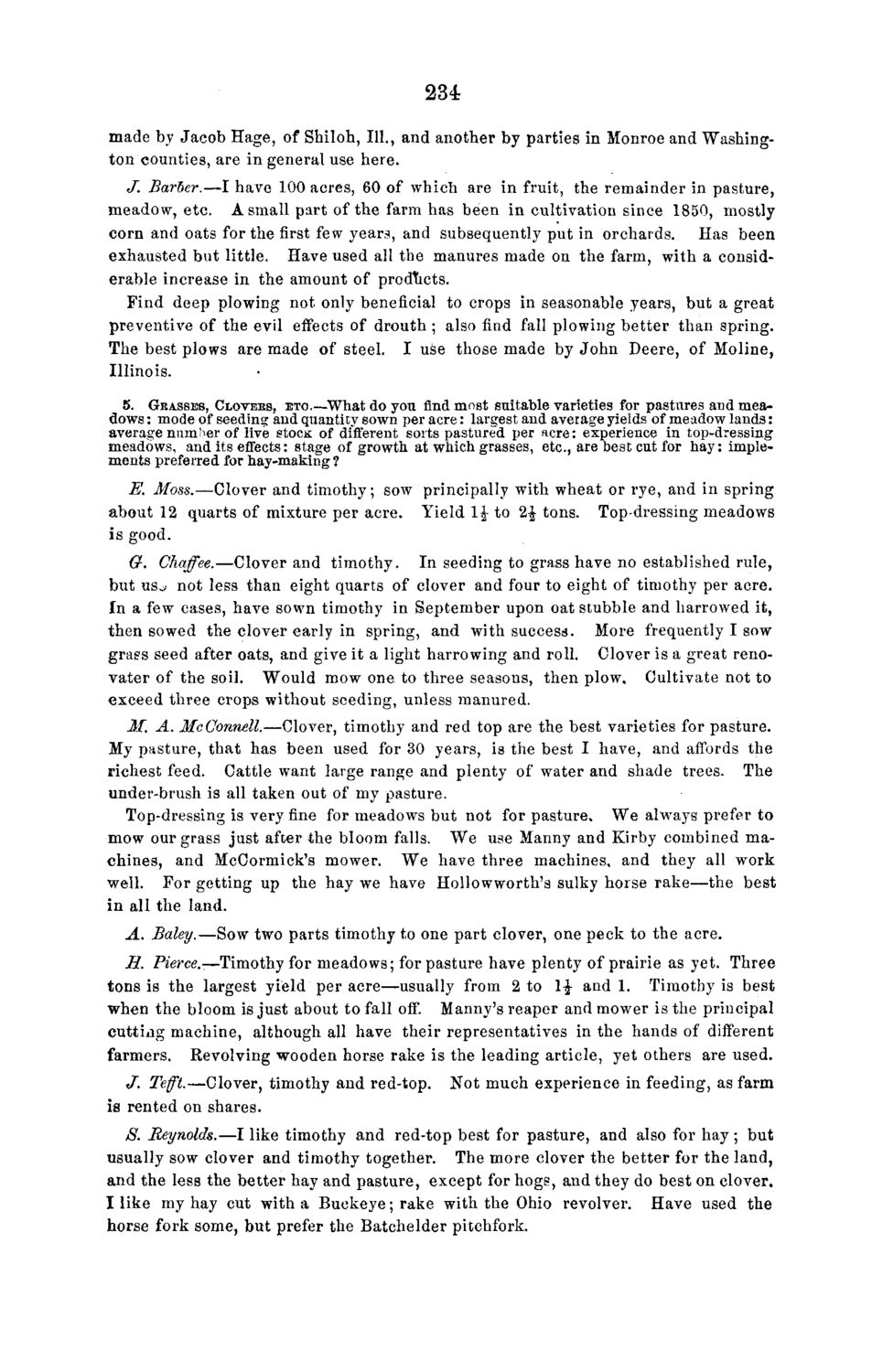| |
| |
Caption: Board of Trustees Minutes - 1868
This is a reduced-resolution page image for fast online browsing.

EXTRACTED TEXT FROM PAGE:
234 made by Jacob Hage, of Shiloh, 111., and another by parties in Monroe and Washington counties, are in general use here. J. Barber.—I have 100 acres, 60 of which are in fruit, the remainder in pasture, meadow, etc. A small part of the farm has been in cultivation since 1850, mostly corn and oats for the first few years, and subsequently put in orchards. Has been exhausted but little. Have used all the manures made on the farm, with a considerable increase in the amount of products. Find deep plowing not only beneficial to crops in seasonable years, but a great preventive of the evil effects of drouth ; also find fall plowing better than spring. The best plows are made of steel. I use those made by John Deere, of Moline, Illinois. 5. GRASSES, CLOVEBS, ETO.—What do you find most suitable varieties for pastures and meadows: mode of seeding and quantity sown per acre: largest and average yields of meadow lands: average number of live stocs of different sorts pastured per acre: experience in top-dressing meadows, and its effects: stage of growth at which grasses, etc., are best cut for hay: implements preferred for hay-making ? E. Moss.—Clover and timothy; sow principally with wheat or rye, and in spring about 12 quarts of mixture per acre. Yield 1£ to 2£ tons. Top-dressing meadows is good. G. Chaffee.—Clover and timothy. In seeding to grass have no established rule, but us^- not less than eight quarts of clover and four to eight of timothy per acre. In a few cases, have sown timothy in September upon oat stubble and harrowed it, then sowed the clover early in spring, and with succesd. More frequently I sow grass seed after oats, and give it a light harrowing and roll. Clover is a great renovater of the soil. Would mow one to three seasons, then plow. Cultivate not to exceed three crops without seeding, unless manured. M. A. McConnell.—Clover, timothy and red top are the best varieties for pasture. My pasture, that has been used for 30 years, is the best I have, and affords the richest feed. Cattle want large range and plenty of water and shade trees. The under-brush is all taken out of my pasture. Top-dressing is very fine for meadows but not for pasture. We always prefer to mow our grass just after the bloom falls. We use Manny and Kirby combined machines, and McOormick's mower. We have three machines, and they all work well. For getting up the hay we have Hollowworth's sulky horse rake—the best in all the land. A. Baley.—Sow two parts timothy to one part clover, one peck to the acre. R. Pierce.—Timothy for meadows; for pasture have plenty of prairie as yet. Three tons is the largest yield per acre—usually from 2 to 1^- and 1. Timothy is best when the bloom is just about to fall off. Manny's reaper and mower is the principal cutting machine, although all have their representatives in the hands of different farmers. Revolving wooden horse rake is the leading article, yet others are used. J. Tefft.—Clover, timothy and red-top. is rented on shares. Not much experience in feeding, as farm 8. Reynolds.—I like timothy and red-top best for pasture, and also for hay ; but usually sow clover and timothy together. The more clover the better for the land, and the less the better hay and pasture, except for hogs, and they do best on clover. I like my hay cut with a Buckeye; rake with the Ohio revolver. Have used the horse fork some, but prefer the Batchelder pitchfork.
| |